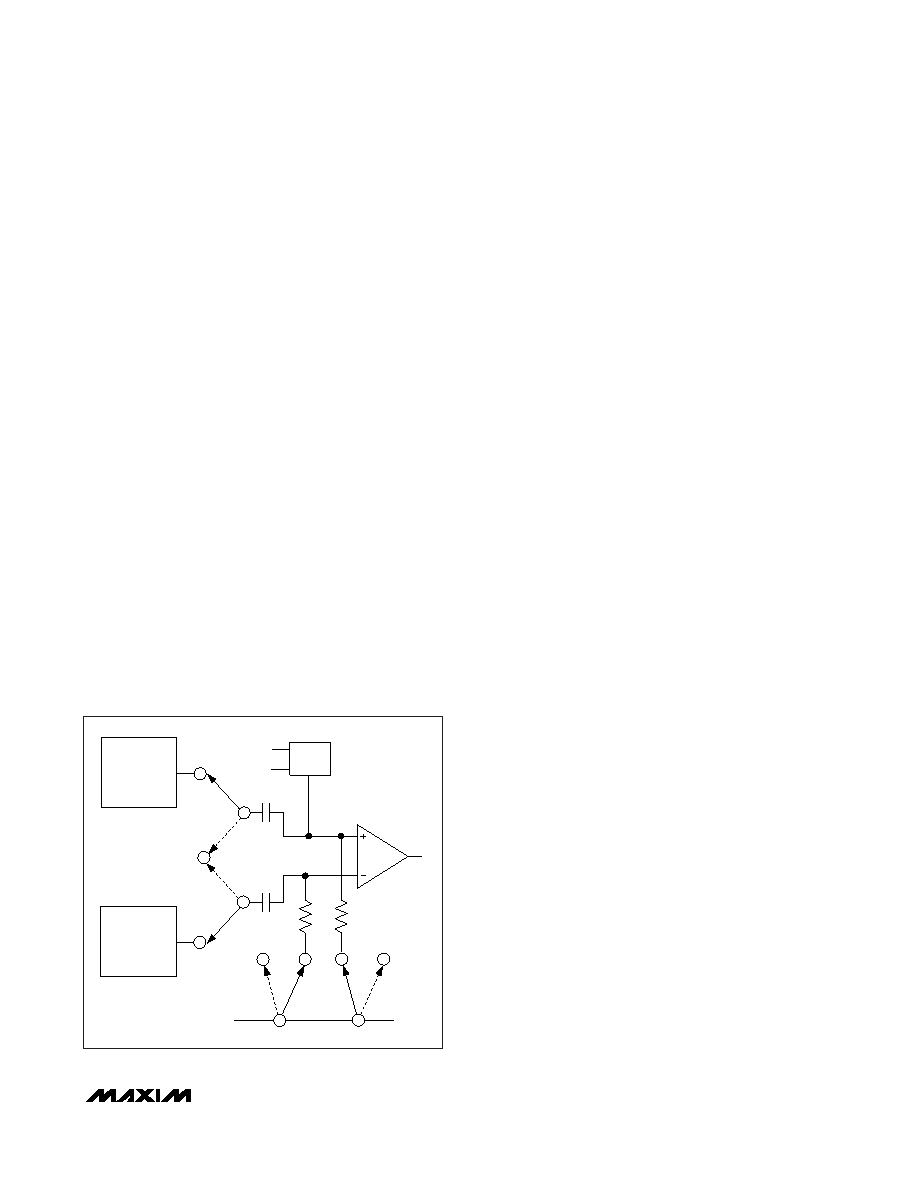- 您現(xiàn)在的位置:買賣IC網(wǎng) > PDF目錄9500 > MAX1048BETX+ (Maxim Integrated Products)IC ADC/DAC 10BIT 36-TQFN-EP PDF資料下載
參數(shù)資料
| 型號: | MAX1048BETX+ |
| 廠商: | Maxim Integrated Products |
| 文件頁數(shù): | 9/39頁 |
| 文件大?。?/td> | 0K |
| 描述: | IC ADC/DAC 10BIT 36-TQFN-EP |
| 產(chǎn)品培訓模塊: | Lead (SnPb) Finish for COTS Obsolescence Mitigation Program |
| 標準包裝: | 50 |
| 類型: | ADC,DAC |
| 分辨率(位): | 10 b |
| 采樣率(每秒): | 225k |
| 數(shù)據(jù)接口: | 串行 |
| 電壓電源: | 模擬和數(shù)字 |
| 電源電壓: | 4.75 V ~ 5.25 V |
| 工作溫度: | -40°C ~ 85°C |
| 安裝類型: | 表面貼裝 |
| 封裝/外殼: | 36-WFQFN 裸露焊盤 |
| 供應(yīng)商設(shè)備封裝: | 36-TQFN 裸露焊盤(6x6) |
| 包裝: | 管件 |
第1頁第2頁第3頁第4頁第5頁第6頁第7頁第8頁當前第9頁第10頁第11頁第12頁第13頁第14頁第15頁第16頁第17頁第18頁第19頁第20頁第21頁第22頁第23頁第24頁第25頁第26頁第27頁第28頁第29頁第30頁第31頁第32頁第33頁第34頁第35頁第36頁第37頁第38頁第39頁

MAX1040/MAX1042/MAX1046/MAX1048
10-Bit, Multichannel ADCs/DACs with FIFO,
Temperature Sensing, and GPIO Ports
______________________________________________________________________________________
17
Unipolar or Bipolar Conversions
Address the unipolar- and bipolar-mode registers
through the setup register (bits 1 and 0). See Table 5 for
the setup register. See Figures 3 and 4 for the transfer-
function graphs. Program a pair of analog inputs for dif-
ferential operation by writing a one to the appropriate bit
of the bipolar- or unipolar-mode register. Unipolar mode
sets the differential input range from 0 to VREF1. A nega-
tive differential analog input in unipolar mode causes the
digital output code to be zero. Selecting bipolar mode
sets the differential input range to ±VREF1 / 2. The digital
output code is binary in unipolar mode and two’s com-
plement in bipolar mode.
In single-ended mode, the MAX1040/MAX1042/
MAX1046/MAX1048 always operate in unipolar mode.
The analog inputs are internally referenced to AGND
with a full-scale input range from 0 to the selected refer-
ence voltage.
Analog Input (T/H)
The equivalent circuit of Figure 2 shows the ADC input
architecture of the MAX1040/MAX1042/MAX1046/
MAX1048. In track mode, a positive input capacitor is
connected to AIN0–AIN7 in single-ended mode and
AIN0, AIN2, AIN4, and AIN6 in differential mode.
A negative input capacitor is connected to AGND in
single-ended mode or AIN1, AIN3, AIN5, and AIN7 in
differential mode. For external T/H timing, use clock
mode 01. After the T/H enters hold mode, the difference
between the sampled positive and negative input volt-
ages is converted. The input capacitance charging rate
determines the time required for the T/H to acquire an
input signal. If the input signal’s source impedance is
high, the required acquisition time lengthens.
Any source impedance below 300Ω does not signifi-
cantly affect the ADC’s AC performance. A high-imped-
ance source can be accommodated either by
lengthening tACQ (only in clock mode 01) or by placing
a 1F capacitor between the positive and negative ana-
log inputs. The combination of the analog-input source
impedance and the capacitance at the analog input cre-
ates an RC filter that limits the analog input bandwidth.
Input Bandwidth
The ADC’s input-tracking circuitry has a 1MHz small-sig-
nal bandwidth, making it possible to digitize high-speed
transient events and measure periodic signals with
bandwidths exceeding the ADC’s sampling rate by
using undersampling techniques. Anti-alias prefiltering
of the input signals is necessary to avoid high-frequency
signals aliasing into the frequency band of interest.
Analog Input Protection
Internal electrostatic-discharge (ESD) protection diodes
clamp all analog inputs to AVDD and AGND, allowing
the inputs to swing from (AGND - 0.3V) to (AVDD +
0.3V) without damage. However, for accurate conver-
sions near full scale, the inputs must not exceed AVDD
by more than 50mV or be lower than AGND by 50mV. If
an analog input voltage exceeds the supplies, limit the
input current to 2mA.
Internal FIFO
The MAX1040/MAX1042/MAX1046/MAX1048 contain a
first-in/first-out (FIFO) buffer that holds up to 16 ADC
results plus one temperature result. The internal FIFO
allows the ADC to process and store multiple internally
clocked conversions and a temperature measurement
without being serviced by the serial bus.
If the FIFO is filled and further conversions are request-
ed without reading from the FIFO, the oldest ADC
results are overwritten by the new ADC results. Each
result contains 2 bytes, with the MSB preceded by four
leading zeros. After each falling edge of
CS, the oldest
available pair of bytes of data is available at DOUT,
MSB first. When the FIFO is empty, DOUT is zero.
The first 2 bytes of data read out after a temperature
measurement always contain the 10-bit temperature
result, preceded by four leading zeros, MSB first. The
LSB is followed by 2 sub-bits. If another temperature
measurement is performed before the first temperature
result is read out, the old measurement is overwritten
by the new result. Temperature results are in degrees
AIN0–AIN7
(SINGLE-ENDED),
AIN0, AIN2,
AIN4, AIN6
(DIFFERENTIAL)
COMPARATOR
HOLD
ACQ
HOLD
ACQ
HOLD
AVDD / 2
REF1
AGND
CIN+
CIN-
DAC
AGND
(SINGLE-ENDED),
AIN1, AIN3,
AIN5, AIN7
(DIFFERENTIAL)
Figure 2. Equivalent Input Circuit
相關(guān)PDF資料 |
PDF描述 |
|---|---|
| FST3253MTCX | MUX/DEMUX DUAL 4:1 TTL 16TSSOP |
| MAX188AEWP+ | IC ADC 12BIT SERIAL 20-SOIC |
| MAX197AEAI+ | IC DAS 12BIT SNGL 28-SSOP |
| MAX11359AETL+ | IC DAS SYSTEM 16BIT 40-TQFN |
| MS27474T8B98P | CONN RCPT 3POS JAM NUT W/PINS |
相關(guān)代理商/技術(shù)參數(shù) |
參數(shù)描述 |
|---|---|
| MAX1048BETX+ | 功能描述:ADC / DAC多通道 10Bit AD/DACs w/FIFO Temp Sns & GPIO Port RoHS:否 制造商:Texas Instruments 轉(zhuǎn)換速率: 分辨率:8 bit 接口類型:SPI 電壓參考: 電源電壓-最大:3.6 V 電源電壓-最小:2 V 最大工作溫度:+ 85 C 安裝風格:SMD/SMT 封裝 / 箱體:VQFN-40 |
| MAX1048BETX+T | 功能描述:ADC / DAC多通道 10Bit AD/DACs w/FIFO Temp Sns & GPIO Port RoHS:否 制造商:Texas Instruments 轉(zhuǎn)換速率: 分辨率:8 bit 接口類型:SPI 電壓參考: 電源電壓-最大:3.6 V 電源電壓-最小:2 V 最大工作溫度:+ 85 C 安裝風格:SMD/SMT 封裝 / 箱體:VQFN-40 |
| MAX1048BETX-T | 功能描述:ADC / DAC多通道 RoHS:否 制造商:Texas Instruments 轉(zhuǎn)換速率: 分辨率:8 bit 接口類型:SPI 電壓參考: 電源電壓-最大:3.6 V 電源電壓-最小:2 V 最大工作溫度:+ 85 C 安裝風格:SMD/SMT 封裝 / 箱體:VQFN-40 |
| MAX1049 | 制造商:MAXIM 制造商全稱:Maxim Integrated Products 功能描述:10-Bit, Multichannel ADCs/DACs with FIFO, Temperature Sensing, and GPIO Ports |
| MAX104CHC | 制造商:Maxim from Components Direct 功能描述:MAX104CHC ANALOG TO DIGITAL CONVERTERS (ADC) - Trays 制造商:Maxim 功能描述:Maxim Integrated Products MAX104CHC Analog to Digital Converters (ADC) |
發(fā)布緊急采購,3分鐘左右您將得到回復。